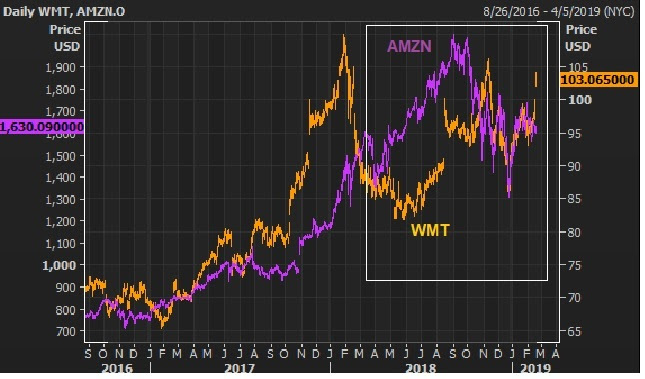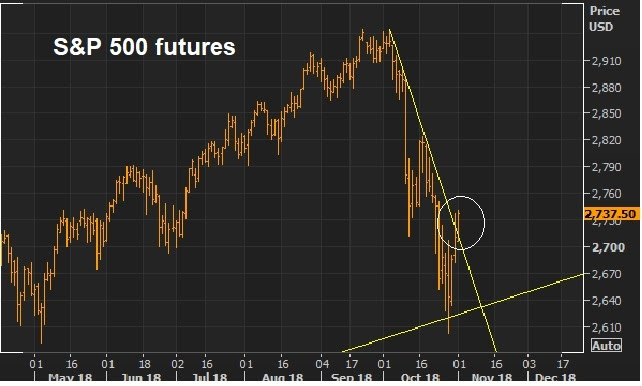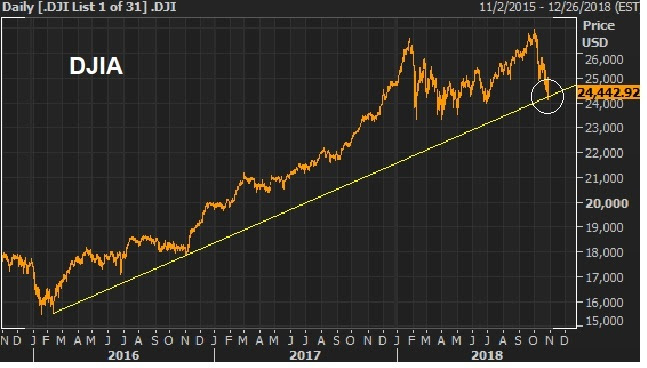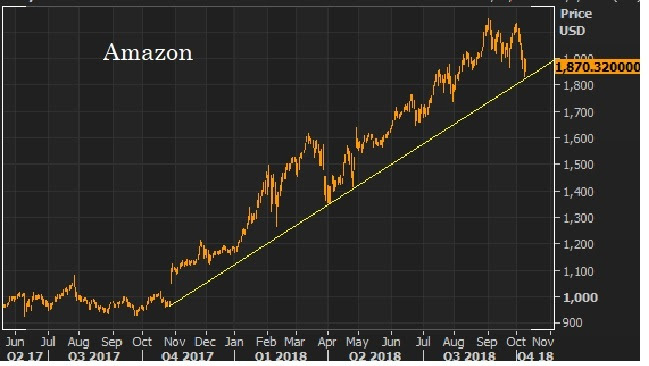|
|
November 26, 5:00 pm EST After a down 7% October, the S&P 500 was down another 3% for November as we started the week. But stocks had a nice day, continuing to bounce from this big trendline we’ve been watching over the past week. |
 |
|
And the better news: We have potential positive catalysts on the docket for this week that could put a final stamp on this correction. Powell (Fed Chair) gives a prepared speech on Wednesday at the Economic Club of New York. Remember, we were looking for some signal a couple of weeks ago that the Fed might take a pause normalizing rates. We got it, but from the Atlanta Fed President. This week, any indication from the Fed Chair that rate hikes are nearing an end would be a greenlight for stocks. And then we get new information on U.S./China trade relations by the week’s end as Trump and Xi are scheduled for a sit down at the G20 meetings. Among all of the concerns that might be curbing risk appetite (both in markets and the economy) this one is among the biggest. Progress on that front should also trigger relief in stocks. The combination of a more dovish Fed and some clarity on trade would set up for what could be a very aggressive bounce for stocks into the year end. What stocks do you buy? Join me here to get my curated portfolio of 20 stocks that I think can do multiples of what broader stocks do, coming out of this market correction environment.
|
|
|
|
|
|
|
October 12, 5:00 pm EST
The S&P 500 has declined more than 5% (from peak to trough) on four different occasions this year. That’s despite an economy that is heating up, finally escaping the slow growth rut of the past decade.
So, should you be fearful when these declines occur, or should you be greedy?
During market declines – with the constant barrage of market analysis and opinion on financial television, in newspapers, or through the Internet – it’s easy to get sucked into drama played out in the media.
And that tends to make many investors fearful.
But while the fearful start running out of the store when stocks go on sale, the best billionaire investors in the world, start running IN.
The fact is, the best investors in the world see declines in the U.S. stock market as an exciting opportunity. And so should you.
Most average investors in stocks are NOT leveraged. And with that, they should have no concern about U.S. stock market declines, other than saying to themselves, “what a gift,” and asking themselves these questions: “Do I have cash I can put to work at these cheaper prices? And, where should I put that cash to work?”
Billionaire Ray Dalio, the founder of the biggest hedge fund in the world, has said what we think is the most simple yet important fact ever said about investing.
“There are few sure things in investing … that betas rise over time relative to cash is one of them.”
In plain English, he’s saying that major asset classes, over time, will rise (stocks, bonds, real estate). The value of these core assets will grow faster than the value of cash.
That comes with one simple assumption. The world, over time, will improve, will grow and will be a better and more efficient place to live than it was before. If that assumption turned out to be wrong, we have a lot more to worry about than the value of our stock portfolio.
With that said, as an average investor that is not leveraged, dips in stocks (particularly U.S. stocks – the largest economy in the world, with the deepest financial markets) should be bought, because in the simplest terms, over time, the broad stock market has an upward sloping trajectory.
This is the very simple philosophy Dalio follows, and is the core of how he makes money and how he has become one of the best, and richest, investors alive.
Billionaires Bill Ackman and Carl Icahn, two of the great activist investors, lick their chops when broad markets sell off on fear and uncertainty.
Ackman says he gets to buy stakes in high quality businesses at a discount when broad markets decline for non-fundamental reasons. Icahn says he hopes a stock he owns goes lower so he can buy more.
What about the great Warren Buffett? What does he think about market declines? He has famously attributed his long-term investing success to “being greedy when others are fearful.”
Bottom line: Declines in the broad market are times to take out your shopping list.
If you need help with your shopping list, join me in my Billionaire’s Portfolio. We follow the world’s bests billionaire investors into their favorite stocks. Click here to learn more.
|
October 9, 5:00 pm EST There are always plenty of risks surrounding markets. Still, stocks tend to be pretty good at “climbing the wall of worry.”
But we’ve now had some swings since the beginning of the month. Have stocks hit the wall at the recent record highs? Have the growing geopolitical risks begun to finally outweigh the fundamental strength in the economy and the stock market? Not likely. More likely, these risks have served as a catalyst for a correction. In this case, a correction in tech stocks. And it has been driven by one of the highest flyers: Amazon. At the highs of last month, Amazon had jumped 112% in a little less than 12 months. That’s over $500 billion in market cap gains for Amazon since September of last year. Just that increase in valuation alone is bigger than all but four stocks in the world. So, as we’ve been discussing in this daily note for quite some time, the regulatory screws have been tightening on big tech. And Amazon is in the crosshairs. Meanwhile, it has been priced as if the developing monopoly would go unchecked. As I’ve said, “not a good bet.” Now that “monopoly premium” seems to finally be deflating. After crossing the trillion-dollar valuation threshold (which was the dead top in the stock), Amazon has now had an official 10% correction. |
 |
| This big trendline in Amazon will be key to watch.
If you haven’t joined my Billionaire’s Portfolio, where I hand select a 20-stock portfolio of the best billionaire owned and influenced stocks, you can join me here. |













